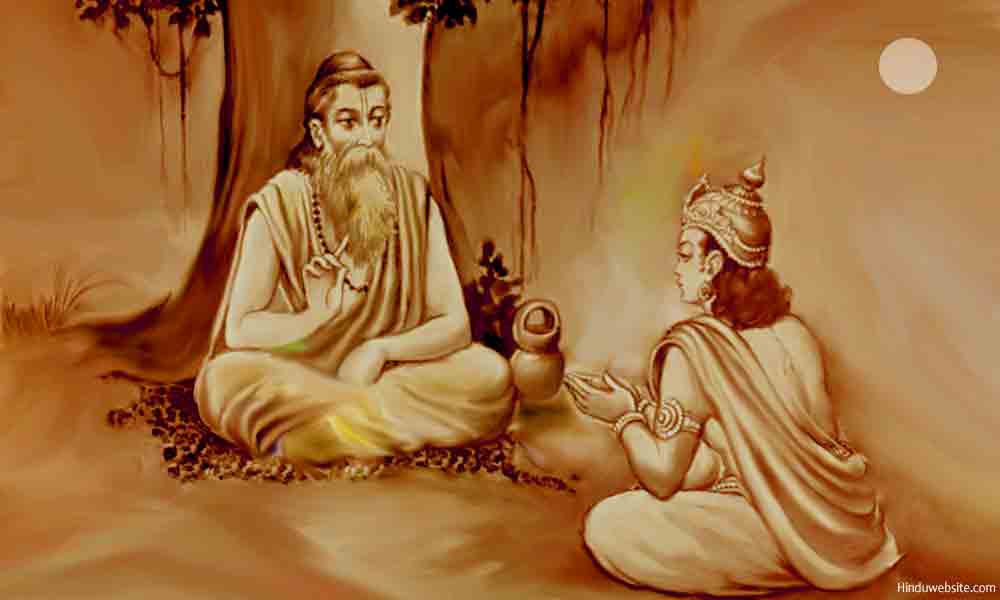
Ashtavakra Samhita, Chapter 1, Verse 2

Contents
Index, Verse 1, Verse 2, Verse 3, Verse 4, Verse 5, Verse 6, Verse 7, Verse 8, Verse 9, Verse 10, Verse 11, Verse 12, Verse 13, Verse 14, Verse 15, Verse 16, Verse 17, Verse 18, Verse 19, Verse 20
Verse 2
Ashtavakra uvacha, muktim
icchasi chetat vishayanvishavatyaja
kshama aarjava daya tosha satyam piyushavat bhaja
Translation
Ashtavakra said, "O child, if liberation is what you intend, give up the sense objects as if they are poison and take recourse to forgiveness, straightforwardness, kindness, contentment and truth as if they are nectar."
Meaning
Cultivating spiritual qualities
Ashtavakra addressed Janaka as a child. We do not the age of Janaka nor of Ashtavakra. However, we presume that Ashtavakra was much older than Janaka and considered considered him a novice or an initiate in spiritual matters. Hence, he probably chose the title child to address him. Symbolically, it means anyone who has not entered spiritual life or does not possess spiritual knowledge is equal to a child.
Visha means poison and vishaya means sense-objects. Any material object that you seek in the world is a vishaya. All objects are considered poisonous in Hinduism because they bind humans to the cycle of births and deaths. Those who seek worldly objects cannot escape death. Hence all material objects (vishayan) are considered equal to poison (visham).
Thus, in the beginning statement itself, Ashtavakra introduced the importance of renunciation as the foremost requisite for liberation. He followed it up by referring to five important sattvic qualities that are important for its practice.
No English translation of Sanskrit verses fully conveys the depth and breadth of their intent and purpose. Any translation is a close approximation, a struggle for a scholar to find the right combination of words and phrases to convey their meaning along with any hidden symbolism, idiomatic expression, cultural peculiarities, and associated secondary meanings. It is easier to gloss over their meaning, which many translators do, but in that we lose the power and the force hidden in those words.
Therefore, we pay here a little more attention to the words used by Ashtavakra to denote the five qualities, kshama, aarjava, daya, thosha, and satyam. Kshama is the quality of endurance, patience, silent suffering, letting go, and forgiveness. Aarjavam means mellowness, straightforwardness, sincerity, honesty, simplicity and humility. Daya means tenderness, pity, kindness or compassion which arises from the virtue of non-violence and leads to the same.
Tosha means contentment, satisfaction, or delight. It is a resultant expression of renunciation, detachment, and sameness. When you have these you remain either contended (tosha) or happy (samtosham), irrespective of the situation in which you may find yourself. Satyam means truthfulness. Truthfulness not only means speaking truth but also seeing truth, knowing truth, understanding truth, and discerning truth. It happens only when you have cultivated the quality of sattva.
When your mind (citta) is filled with sattva, truths will accurately reflect in your consciousness, just as images are reflected in a clean and dust-free mirror. Hence, in the Bhagavadgita you will find a great emphasis upon refining and purifying the intellect (buddhi) to cultivate the quality of discernment and see things as they are without mental filters and cognitive bias.
Ashtavakra asked Janaka to seek these five qualities. The words he used in this connection was bhaja. Bhaja does not mean mere seeking. It also means to uphold, appreciate, respect, honor, worship, acquire, possess and remain devoted to. In other words, the advice was not meant for mere knowledge. Janaka was expected to internalize those qualities in him and reflect them in his thoughts and deeds.
He also said that Janaka should accept them as if they are nectar. Piyusha is usually translated as nectar or ambrosia (amrit), but it also means fresh cow milk, especially from a cow that has just given birth to a calf. The implication is however clear. The comparison is made to denote their value to attain immortality (amritatvam) or overcome the poisonous death.
Suggestions for Further Reading
- Om, Aum, Pranava or Nada in Mantra and Yoga Traditions
- Brahmacharya or Celibacy in Hinduism
- Atheism and Materialism in Ancient India
- Solving the Hindu Caste System
- How To Choose Your Spiritual Guru?
- Creation in Hinduism As a Transformative Evolutionary Process
- Wealth and Duty in Hinduism
- Do You Have Any Plans For Your Rebirth or Reincarnation?
- Understanding Death and Impermanence
- Lessons from the Dance of Kali, the Mother Nature
- Letting your God live in You - The True Essence of the Hindu Way of Life
- prajnanam brahma - Brahman is Intelligence
- Maslow's Hierarchy Of Needs From The Perspective Of Hinduism
- The Definition and Concept of Maya in Hinduism
- The Meaning of Nirvana
- Self-knowledge, Difficulties in Knowing Yourself
- Hinduism - Sex and Gurus
- The Construction of Hinduism
- The Meaning and Significance of Heart in Hinduism
- The Origin and Significance of the Epic Mahabharata
- The True Meaning of Prakriti in Hinduism
- Three Myths about Hinduism
- What is Your Notion of God?
- Why Hinduism is a Preferred Choice for Educated Hindus
- Essays On Dharma
- Esoteric Mystic Hinduism
- Introduction to Hinduism
- Hindu Way of Life
- Essays On Karma
- Hindu Rites and Rituals
- The Origin of The Sanskrit Language
- Symbolism in Hinduism
- Essays on The Upanishads
- Concepts of Hinduism
- Essays on Atman
- Hindu Festivals
- Spiritual Practice
- Right Living
- Yoga of Sorrow
- Happiness
- Mental Health
- Concepts of Buddhism
- General Essays